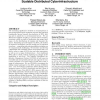Free Online Productivity Tools
i2Speak
i2Symbol
i2OCR
iTex2Img
iWeb2Print
iWeb2Shot
i2Type
iPdf2Split
iPdf2Merge
i2Bopomofo
i2Arabic
i2Style
i2Image
i2PDF
iLatex2Rtf
Sci2ools
HPDC
2010
IEEE
2010
IEEE
Exploring the RNA folding energy landscape using scalable distributed cyberinfrastructure
The increasing significance of RNAs in transcriptional or post-transcriptional gene regulation processes has generated considerable interest towards the prediction of RNA folding and its sensitivity to environmental factors. We use Boltzmann-weighted sampling to generate RNA secondary structures, which are used to characterize the energy landscape, via the distributions of energies and base-pair distances. Depending upon the length of an RNA, the number of sequences investigated, and the sample size of generated structures -- generating and analyzing sufficient samples can be computationally challenging. We introduce and develop a lightweight and extensible runtime environment that is effective across a range of RNA sizes and other parameters, as well as over a range of infrastructure
Distributed And Parallel Computing | Energy Landscapes | HPDC 2010 | RNA Folding | RNA Secondary Structures |
| Added | 09 Nov 2010 |
| Updated | 09 Nov 2010 |
| Type | Conference |
| Year | 2010 |
| Where | HPDC |
| Authors | Joohyun Kim, Wei Huang, Sharath Maddineni, Fareed Aboul-Ela, Shantenu Jha |
Comments (0)

